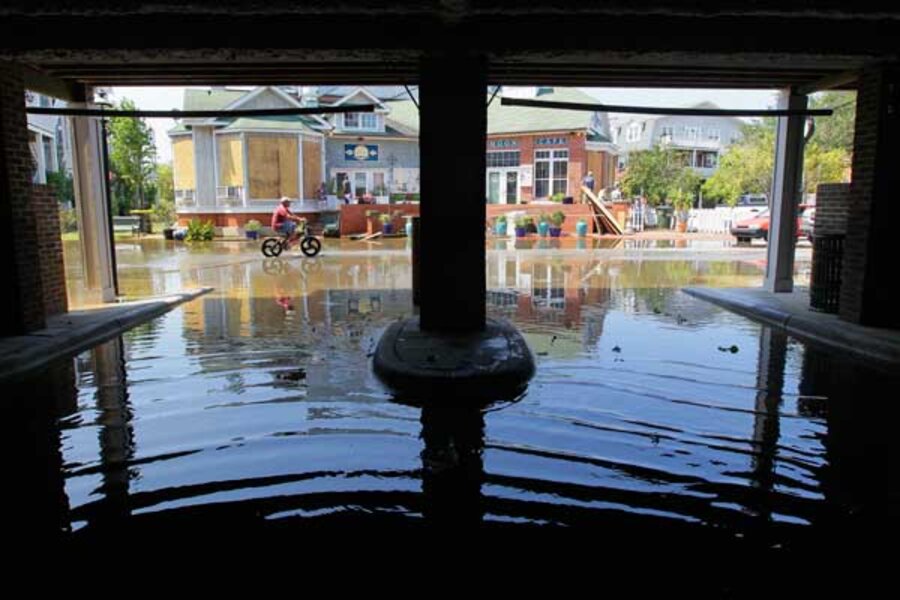Why insurance might not cover billions in hurricane Irene damage
Loading...
| Boston
Hurricane Irene leaves in its wake an economic toll that includes inland flooding, power outages, and costly shutdowns of big-city transit systems.
Although Irene downshifted to a tropical storm before passing through New York City and beyond, damage could still total more than $5 billion, according to one assessment.
Among the storm's largest effects:
- Floods in inland areas. From New Jersey to Vermont, Irene's torrents fell on a region that had already been saturated by thunderstorms in the week or so before. Many rivers won't crest for 36 hours or so, and important stretches of the Connecticut River not until Wednesday.
- Power outages. More than 5 million homes and businesses were without power from North Carolina to Maine on Monday, with no quick end in sight.
- Lost business activity. Consumers in America's most densely populated region hunkered in their homes instead of going to malls or movie theaters. Although the storm came on a weekend, its effects also spilled into the work week as some transit routes struggled to get running for commuters on Monday.
That's a partial list. Other losses include many homes damaged by surging surf or by wind and blown-down trees. Highway 12 in North Carolina was cut in several places. And in Tuxedo Park, N.Y., more than a dozen heating-oil trucks were swept into the Ramapo River as a stream overflowed, The Wall Street Journal reported.
It could have been worse
Despite all the losses, perhaps the most important point is what didn't happen. The region was spared from a much-worse toll due to Irene's weakened wind speeds.
"We were lucky," says Tom Larsen, a senior vice president at EQECAT, a risk-modeling firm based in Oakland, Calif. "It wouldn't have taken much more energy in the winds to really have significantly more far-reaching damage."
As blue sky bathed the Northeast on Monday, millions of residents returned to daily activities mostly as normal.
Insurance companies could breath a sigh of relief: The share prices of firms such as Allstate and Travelers posted sizable gains Monday morning, leaving the stocks little-changed in price over the past 10 days.
Even with its diminished winds, the storm ranks as "significant ... because it hit such a populous area, and in an area that hasn't seen hurricanes for a while," Mr. Larsen says.
His firm expects to release an estimate of damage in the Northeast later Monday. Already, EQECAT has pegged insured losses in the Caribbean at $300 million to $600 million, and in the Carolinas at $200 million to $400 million.
The forecasting firm Kinetic Analysis, in an estimate prepared as the storm was weakening in strength and nearing New York, predicted that Irene's economic damage will total $5 billion to $10 billion, with the likeliest outcome in the middle of that range.
Why Irene could baffle insurance
A majority of the damage, in the end, will be items not covered by insurance claims, both firms say.
That's not unusual for hurricanes, but there are several reasons why it's the case for Irene in particular.
One is that the storm delivered more of its impact through floods than wind.
Much flood damage won't be covered by insurance, since relatively few Americans participate in the National Flood Insurance Program. Still, if floods block access to a commercial properties, insurance policies might allow interruption-of-business claims, Larsen says.
Another factor affecting insurance liabilities: Insurers have boosted wind-damage deductibles in recent years, so homeowners will often bear costs equaling several percentage points of a home's value.
Much of the storm's impact comes in economic activity that is shifted or postponed rather than lost entirely.
For instance, consumer "back to school" spending will still occur, but with an Irene delay.
By Monday, air travel at the major New York City airports was resuming, after a weekend in which some 9,000 flights along the East Coast were canceled. New York's subway system also restarted, but commuter rail lines near the city were disrupted as crews worked to clear debris from tracks.
Some economists offered higher tallies of potential losses.
Peter Morici, a University of Maryland economist, estimated that if the storm caused roughly two days of economic activity to be lost (spread over a week), that might might total $20 billion in this thickly populated region, he estimates.
After an initial hit to the economy, he adds in a written analysis, there's often a swing in the other direction, as people catch up on postponed spending or rebuild with help from insurance payments.
But in its report, Kinetic Analysis noted that Irene comes as consumers and governments don't have a lot of spare cash.
"Irene is potentially different in impact [from other storms] given the weaker state of the overall economy," the report said. Many businesses and homeowners "can't handle another shock to the budget.... Insurance won't be covering as much, government budgets are stretched, and there is a question mark as to if banks will want to loan money to cover repairs or cover operating losses in vulnerable areas."
Storm cleanup will also affect tourism business for coastal region on Labor Day weekend.





